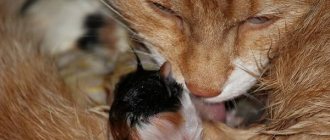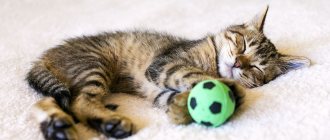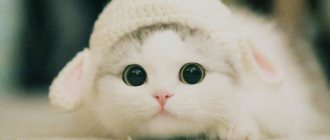Why are kittens born blind?
A mother cat bears 2–8 cubs at once. A normal cat pregnancy lasts eight to ten weeks. Of course, the animal cannot carry such a number of kittens for a long time, which is why the kittens are born blind, and they learn to navigate in space and find their mother’s nipples by smell.
Newborn kittens are blind, they are also deaf and completely dependent on their mother cat.
After birth, kittens are deaf, cannot regulate body temperature, or empty their bladder and intestines on their own. Therefore, in the first days of life, babies are completely dependent on the mother cat.
Can a kitten be born with open eyes?
If the mother carried the cubs, then the early opening of the eyes can be called a natural process. But if the kittens were born with their eyes open, then it is better to show the babies to a veterinarian, who will determine whether their physiological development has completed. When this is not completed, he will prescribe special saline solutions to wet the eyes until the kittens begin to produce tears on their own (usually by two weeks of age). In addition, if necessary, you can use antibiotic ointments (for example, tetracycline ophthalmic ointment 1%). It is also important to ensure that the kitten is in a dark place, because bright light will be harmful to the eyes.
You can try to connect the eyelids with adhesive tape, so that the kitten's eye is closed with eyelids, as is the case in its natural state. Then the eyes will be properly moistened with tears.
It is imperative to care for the kittens at this time, since if there is no action on the part of the owner, they can go blind.
A kitten can be born with open eyes due to developmental anomalies, or in the absence of any abnormalities
It happens that the eyes of newborn kittens are open due to a congenital genetic anomaly. Unfortunately, in this case the animals are considered non-viable.
Possible causes of eye inflammation
Excessive tearing, typical of British Shorthairs or Scottish Folds, can cause eye irritation. To prevent infection or foreign objects and dust from entering the visual organs, it is necessary to regularly perform the washing procedure.
How to wash a kitten's eyes
For preventive purposes, eye treatment for kittens is not carried out; it is recommended only when pronounced changes in the animal’s condition are detected, after an injury, infection, or the development of an allergic reaction.
- Consequences of injury
Damage to the eye causes copious discharge of clear or watery fluid, which becomes a crust when it dries. The animal experiences general malaise, the condition is aggravated by constant itching and frequent blinking.
- Foreign object
Irritating particles or dust accumulation when entering the tear ducts causes compression, which causes irritation and inflammation of the kitten's eyes.
- Conjunctivitis
Infectious damage to the mucous membrane of the eye causes not only redness of the visual organ. The pathology provokes the appearance of ulcers on the mucous membrane, severe itching, and copious clear discharge. The kitten begins to react sharply to light.
Important! In severe forms of the disease, discharge from the eyes becomes purulent in nature, and there is a serious risk of a sharp and irreversible decrease in vision.
- Viral infections
Abundant cloudy discharge from the eyes, accompanied by an increase in body temperature and loss of appetite, indicates a viral infection. Pathology can cause severe disturbances in the functioning of the lacrimal canals.
When infected with a virus, the kitten becomes lethargic and cloudy discharge appears from the eyes.
- Allergy
Excessive lacrimation accompanied by redness of the eyes may be a consequence of the accumulation of allergens. The kitten suffers from itching of the visual organs. Washing the eyes makes the animal feel better.
- Turn of the century
The violation provokes constant irritation of the eye mucosa. Restoring the natural state of the eyelid ensures that the kitten is relieved of increased lacrimation, pain and anxiety.
When do kittens' eyes open?
Normally, kittens' eyes open on the 6th–14th day. However, this process depends on several factors.
Individual characteristics
The process of opening eyes in kittens may depend on the individual characteristics of the mother and babies. So, kittens can see the light later due to diseases of the mother cat or insufficient milk production in her body. If there is not enough of it, then the eyes will open later.
Gestation time
When born at less than eight weeks of gestation, the kittens' eyes will open around the 14th day. If the cat carried babies, then they may well be born with open eyes, as mentioned above, or open them on the 5th–7th day.
Breed
Expect late eye opening in kittens of the following breeds:
- Persian;
- British;
- Scottish.
These kittens will see the light of day no earlier than 10–14 days after birth. But the eyes of babies of the following breeds will open quickly:
- Devon Rex;
- Cornish Rex;
- Siamese;
- ragdoll;
- Thai;
- sphinx (3 days after birth).
These kittens open their eyes on the 5th–7th day or are already born sighted.
According to statistics, short-haired cats begin to see earlier than long-haired ones.
Photo gallery: cat breeds whose kittens quickly open their eyes
Devon Rex kittens will quickly delight their owners by opening their eyes Cornish Rex kittens open their eyes 5–7 days after birth
Siamese kittens will quickly see the light after birth
Ragdoll kittens are sometimes born sighted
Thai kittens' eyes open around the sixth day after birth.
Sphynx kittens open their eyes earlier than others - on the third day after birth.
Floor
Usually, cat girls open their eyes earlier than boys. However, soon the seals catch up with the female cats, and sometimes open their eyes earlier, and the difference in the development of animals of both sexes becomes unnoticeable. This feature is difficult to explain - statistics show this.
Lighting
It is recommended to place the box with the cat and kittens in a dark place, since here the babies’ eyes will open earlier. But in a brightly lit room this will happen later.
All newborn kittens have dull blue eyes. Usually by one and a half months this feature disappears, and the real color of the babies’ eyes can be seen.
Cleaning products
The use of medications to treat a kitten is aimed at relieving pain, eliminating dried crust, preventing further souring of the eyes and reducing visual acuity.
How to brush a cat's teeth: options at home
When choosing a treatment agent, it is necessary to take into account not only the patient’s age, but also the specific course of the pathology.
Boric acid
A solution for washing the animal's eyes is prepared by mixing 1 tbsp. boiled water and 5 g of boric acid powder. The ingredients are stirred until completely dissolved. The medicine is used twice a day for external treatment.
The duration of therapy corresponds to 3-7 days until the appearance of unnatural discharge completely ceases. The drug is used to wash the eyes using sterile bandages or cotton swabs.
Important! Before rinsing your cat's eyes with this product, you need to make sure that the area of exposure does not have open wounds or areas with foci of purulent or fungal infection.
The use of this method of therapy is allowed only for non-infectious causes of discharge; it is not recommended for kittens injured in fights with other animals.
Saline
You can treat your pet's eyes only with a solution at a concentration of 0.9%, otherwise there is a risk of burns to the cornea upon contact with the drug.
The medicine can be used for rinsing or instillation. The frequency of treatment is 2 times a day, the duration of therapy is 2 weeks.
Chlorhexidine 0.01%
The use of Chlorhexidine for cats helps to alleviate the condition of the animal when affected by infection or injury. The drug belongs to the group of effective and mildly acting antiseptics with a minimal set of contraindications. The medicine is used only in the specified concentration, so as not to provoke the development of an allergic reaction, irritation or burn to the eye mucosa.
Considering the low cost of the medicine, owners often check with veterinarians whether it is possible to wash their cat’s eyes with Chlorhexidine. This remedy is effective in fighting bacterial infections and prevents infection of open wounds. The drug can be applied externally or dropped into each eye, 1 drop. The procedure is repeated three times a day. Duration of therapy is from 3 to 7 days.
To prepare the solution take:
- saline solution 16 ml;
- Chlorhexidine at a concentration of 0.05% 4 ml;
- syringe for 20 cc.
The ingredients are thoroughly mixed in a syringe to prevent foreign substances from entering the medicinal solution.
Important! The medication, with prolonged use or non-compliance with the dosage, can provoke increased dryness of the mucous membrane, therefore, if it is impossible to independently prepare a solution in the required concentration, it is recommended to replace it with Miramistin. It is dangerous to use hydrogen peroxide for this purpose.
Potassium permangantsovka
A popular eye care product for kittens is potassium permanganate. It is diluted in water at a concentration of 1:5000. In practice, this corresponds to 2-3 crystals per 1 glass of boiled water. The liquid should take on a faint pink tint.
The medicine can be used only if the crystals are completely dissolved, otherwise there is a risk of corneal burn.
Using the medicine, it is recommended to clean dried crusts on the animal’s eyes, treat open wounds, and remove mucus containing pus. The drug can be used before using drops or ointments.
Additional information: if a kitten reacts negatively to a manganese solution, then it can be replaced with Furacilin. This remedy acts more gently and has fewer contraindications.
Drops for cats
The veterinarian should decide how to wipe the eyes of a kitten in the presence of infectious diseases, after conducting the necessary examination of the animal. The list of the most popular medications includes “Diamond Eyes” drops.
Drops "Diamond eyes"
This product has an anti-edematous and antibacterial effect. The medicine can be used to combat acute and chronic pathologies, including those of an allergic nature. It is necessary to treat the eyes with this remedy for 5-14 days - the duration of treatment depends on the severity of the disease.
Ophthal drops help cope with inflammation and irritation caused by sand, dust or a negative response from the animal’s immune system. The duration of treatment is limited to 3 days. Drops are instilled one at a time twice a day.
If the kitten's eyes begin to water due to sand or dust, it is also recommended to use Rosinka lotion. It is enough to apply it on a sterile gauze napkin and wipe the affected organ of vision with it to relieve irritation and alleviate the pet’s condition.
In case of severe conjunctivitis, it is recommended to drop Anandin into the cat's eye. The duration of therapy is limited to 14 days.
Only a veterinarian can prescribe treatment for a bacterial infection.
Only a veterinarian can prescribe what to wipe a kitten’s eyes with if they are affected by a bacterial infection and become sour from purulent mucous discharge. However, experienced animal lovers say that it is most often recommended to use Ciprovet. This broad-spectrum antibiotic is instilled and waited for 5-10 minutes, after which the released liquid is wiped off. The treatment is completed by repeated instillation of the medicine. The duration of treatment is determined by the veterinarian.
Stages of the eye opening process in kittens
The opening of the eyes in babies occurs gradually:
- First, a small crack appears, usually on the inside of the eye.
- Soon the iris becomes completely visible.
- The eyes remain cloudy for a week after opening, so it is not advisable for the kitten to go out into bright light. Usually, the mother cat herself takes the baby out of the shelter when the time comes, or asks the owners to do so.
When I was about 10 years old, my girls and I were nursing blind kittens whose mother cat had died. We bottle fed them. I remember well that the kittens’ eyes began to open unevenly - I was then afraid that they were festering and the process was not going well. In fact, everything was normal, as neighbor Baba Anya told us about. And the next day we saw that the babies’ eyes were completely open. True, the impression still remained that the kittens were blind - it took about another week and a half for them to feel more confident.
At what age does this happen?
The most important event for a cat's baby is the opening of its eyes. The process begins at approximately 2 weeks of life and lasts about 7 days. At first, babies slightly open their slits - their eyes, which become wider every day.
For the first 7 days, newborns do not see or hear anything around. At the beginning of life, it is necessary for them to be in a dark room; bright light negatively affects the development of the visual organs. After opening, the eyes are cloudy, with motionless pupils, until they begin to respond to stimuli and transmit signals from the optic nerves to the brain. After 2-3 days, the pupil becomes mobile, and the membrane of the eyes becomes transparent. After the eyelids open, kittens begin to move more and pay attention to objects that are interesting to them.
About problems and the need to call a veterinarian
Don't panic if the kittens' eyes haven't opened within two weeks. Wait another week and then start taking action.
If the kittens’ eyes have not opened 3 weeks after birth, then you need to contact a veterinarian
Fusion of eyelids
A long absence of eye opening in kittens may indicate fusion of the eyelids. If this problem occurs, the doctor will recommend a light massage. If it does not help, then a simple operation will be required, which is done under local anesthesia. An anesthetic is injected into the corners of the animals' eyes, after which a specialist cuts the eyelid with a sharp scalpel. At the end of the operation, the veterinarian recommends treating the eyes with a special solution (usually a 2% boric acid solution).
Suppuration
When suppuration occurs, the kittens' eyes are washed with tea leaves or medications from the pharmacy - saline solution, boric acid solution, etc. A veterinarian can tell you in detail how to use them. In some cases, he takes the discharge for analysis, thanks to the results of which it is possible to select effective drugs to treat the animal.
Birth of a blind kitten
Kittens are born blind in the full sense of the word quite rarely. If the baby was born blind, then over time his hearing and sense of smell will become well developed, which will allow the kitten to navigate in space and exist separately from its mother. It has been noticed that even the mustache of such animals is noticeably longer than that of their sighted counterparts. If the kitten was born blind, then surgery and treatment will not help.
Video “How to wipe a kitten’s eyes”
From this video you will learn how to properly wipe a kitten's eyes.
Recommended Posts
How to use Bars drops for cats and other preparations: spray, shampoo
How to properly clean a kitten's ears at home
How to properly use the drug "Bars Forte" to protect dogs from parasites
How to successfully name a white kitten boy and girl
Why do dogs have watery eyes: norms and dangerous pathologies
Chondartron for dogs: benefits and possible contraindications
What to do after kittens open their eyes
Caring for babies' opened eyes is necessary. Clean eyes without discharge indicate the health of the kitten. Sometimes dirt can get into the eye or one of the other cats will scratch it, causing inflammation. To exclude such a result, you need to examine your eyes daily and wipe them with a clean cotton pad with boiled water or tea leaves. It’s better to contact a specialist who will recommend special eye drops for kittens. Diamond Eyes or Iris are usually prescribed.
The procedure is carried out as follows:
- Wipe the kitten's eyes with a cotton pad from the inside to the outside.
- Secure the kitten and place the amount of medication recommended by your veterinarian into the inside of the eye.
To prevent inflammation during the first time after the kitten’s eyes open, a special medicine is instilled into them.
- Pat your eye with a dry cotton pad.
With daily care, kittens get used to it and calmly tolerate this procedure. The doctor will schedule an individual time to continue this treatment.
Treatment with tea leaves and instillation is especially necessary until the kitten begins to fully see and confidently navigate. And after that, you can simply examine his eyes every day and, if a problem arises, immediately begin treatment with the help of a veterinarian.
Wiping process
It is important to know how to properly rinse a kitten’s eyes at home so that everything goes smoothly. Before starting the procedure, the owner must wash his hands with soap, prepare a double layer of cotton wool or cotton pads, 5 or 10 cc syringes with a rubber plunger and without a needle.
To secure the pet, wrapped in a comfortable cloth or towel, so that it does not move or escape, you need to call another person. It is best to place the baby lying on his back on his knees. A cotton pad is soaked in the selected solution and squeezed onto the affected mucous membrane. If the eyelids are stuck together, they should be gently wetted before opening.
The disc is passed along the surface of the eyelids, moving from the outer corner to the inner one. You should also change the cotton pad and remove dry discharge. To avoid damaging the stuck eyelashes, the movements are carried out in the opposite direction. After removing the pus and crusts, the solution is carefully poured from a syringe onto the cornea, and the excess is blotted with dry cotton wool or a disk.
We recommend this article:
How to properly bathe a kitten for the first time
Diagnostics in a veterinary clinic
The examination at the clinic will be carried out in several stages.
First, the doctor will ask the owners about known symptoms, the nature of the discharge, the frequency and timing of its appearance. In addition, pet owners can provide information about chronic or recent diseases, which will help reduce the list of causes of possible illness.
Secondly, the veterinarian will examine the kitten himself. He will notice additional symptoms, if any, that the owner may not have paid attention to. Sometimes a survey and examination are enough to make an accurate diagnosis.
A blood test is required if viruses and infection are suspected. To determine the fungal nature of the disease, a smear is taken. The veterinary clinic can also measure blood pressure and prescribe an ultrasound of the eyes and an X-ray of the skull - if there is a suspicion of hidden problems.
Why do cats' eyes fester?
Before you begin treating your pet, it is important to identify the reason why his eyes are festering. This may be due to the presence of certain diseases and injuries. In addition, pus may appear in cases where a previously identified ailment has not been completely cured.
Conjunctivitis
Inflammation of the lining of the eye, also called conjunctivitis, can be caused by allergic reactions or viral or bacterial infections. If this disease is not treated in time, the development of the pathological process continues, which leads to the transition of conjunctivitis to the purulent stage.
Injuries
Purulent discharge in the eye area can also appear in cases where the cat’s eyelid is injured. In this case, not only scratches, but also bruises can cause the appearance of pus. A cat can get them during clashes with other animals, and even during active games with the owner. In these cases, inflammation passes from the eyelid to the eyeball, which entails the appearance of unwanted discharge.
Festering eyes are not an independent disease, but just a symptom
Foreign objects
The appearance of pus can also be caused by foreign objects entering the eye. They irritate the mucous membrane, which leads to the development of inflammation. Your pet's eyes can be damaged by various dust and dirt. Pollen and plant fluff can also cause suppuration. In addition, dirt can get into your pet's eyes during fights with other animals. And even the cat itself, being not clean enough, is capable of introducing small foreign particles into the mucous membrane while washing.
Blepharitis
Blepharitis involves inflammation of the edges of the eyelids. As this type of inflammation develops, pus also appears in the cat's eyes. Blepharitis can be caused by:
- injuries;
- bacteria;
- fungi (trichosporia and microsporia);
- allergic reactions;
- worms;
- poor hygiene.
Keratitis
Inflammation of the cornea (keratitis) is also accompanied by the discharge of pus from the eyes. Like blepharitis, this disease can be caused by injuries, as well as fungal, viral and bacterial infections. In addition, inflammation of the cornea is often caused by hypo- and vitamin deficiency, as well as impaired functioning of the lacrimal glands.
Other reasons
In addition to the above reasons, suppuration can be caused by:
- reduced immunity;
- unbalanced diet;
- exposure to household chemicals and other harmful compounds on the eyes;
- lack of hygiene;
- atopic dermatitis;
- colds caused by hypothermia;
- blocked tear ducts;
- allergy;
- heredity.
Some kittens are born with pathologies that also cause suppuration. Such problems include, for example, the absence of a lacrimal punctum (the inlet of the lacrimal canaliculi), eyelashes growing in several rows. Sometimes there is a pathology in which the lower eyelid turns inward. This leads to irritation of the mucous membrane, inflammation and the subsequent appearance of purulent discharge.
Pedigree animals suffer from purulent discharge more often than their street counterparts, this is especially true for Persian, Scottish and British breeds
How to apply medicinal ointment correctly
Tetracycline ointment is preheated in your hands so as not to frighten the kitten with a cold touch. It is best to turn the animal on its side, fixing it in this state. It is difficult to cope with eye treatment in kittens alone, since one person must hold the cat, and the other must perform the necessary manipulations.
The ointment is placed directly under the lower eyelid, so it must be pulled off very carefully and at the same time with your fingers (your hands should also be warm), and the tetracycline ointment should be placed inside the eyelid with the finger of the other hand. Cover the eyeball with the ointment and lightly massage it for a minute, trying not to cause pain to the kitten. Next, carefully use a disk to remove any remaining ointment that remains on the eyelid and near the eye. Now we’ll talk about medications so that the pet owner does not have the question: “How to treat a kitten’s eyes if they fester?”











